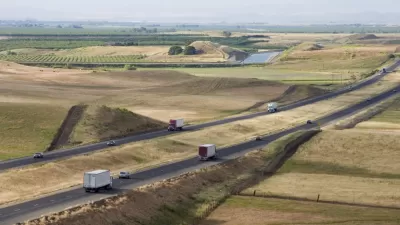Hoping to bypass the Sacramento Superior Court's twin rulings in November that crippled the Calif. High Speed Rail Authority's ability to tap $10 billion in state bond funds, Gov. Brown has petitioned the state Supreme Court to overturn the rulings.
"The Brown administration, which previously downplayed the significance of court rulings against California’s $68 billion high-speed rail project, asked the California Supreme Court to intervene Friday, saying the rulings 'imperil' the project," writes David Siders. As we wrote after the Nov. 25th, Sacramento Superior Court ruling, those two rulings "could sharply curtail the state’s ability to pay for the high-speed rail system in the future."
In a request for expedited review, state officials said “the trial court’s approach to these issues cripples government’s ability to function.” It said the rulings threaten state and federal funding for high-speed rail and could have implications for other infrastructure projects.
The request comes as a bit of a surprise as rail authority board chairman, Dan Richard, had recently claimed, "'We believe we have the funds in hand' to build high speed rail."
“If left to stand, these lower court rulings would not only prevent the state from proceeding quickly to build high-speed rail as the Legislature and voters intended,” Department of Finance spokesman H.D. Palmer said in an email. “They could also inject unwarranted uncertainty into the state’s ability to sell voter-approved bonds in a timely manner to finance public works projects.”
Earlier we noted that the governor had proposed to tap $250 million in the state's cap-and-trade revenues that presumably would be used to meet "an April deadline to make a $180 million payment required to keep the federal money coming."
A sign of 'desperation' is how The Sacramento Bee political columnist Dan Walters described it in his Jan. 25 column. He also explains what happened with the cap-and-trade option, which we perhaps, after all, correctly termed as a Hail Mary pass.
Then Brown said he wanted to use $250 million of “cap-and-trade” fees on business, meant to reduce carbon emissions, apparently to meet the deadline for putting up the state’s share of the project costs this spring without bond money. But that tactic has run into opposition in the Legislature and from its budget analyst, Mac Taylor, who says that it may be illegal.
Finally, to those who had watched or listened to the governor's 17-minute State of the State address on Jan. 22 and were wondering why he gave short shrift to what many view as his ailing legacy project, Siders and Jeremy B. White explain in an earlier piece that it was in recognition that the project is not popular with the voters and Brown is up for reelection this year.
FULL STORY: Jerry Brown asks California Supreme Court to intervene on high-speed rail

Planetizen Federal Action Tracker
A weekly monitor of how Trump’s orders and actions are impacting planners and planning in America.

Chicago’s Ghost Rails
Just beneath the surface of the modern city lie the remnants of its expansive early 20th-century streetcar system.

San Antonio and Austin are Fusing Into one Massive Megaregion
The region spanning the two central Texas cities is growing fast, posing challenges for local infrastructure and water supplies.

Since Zion's Shuttles Went Electric “The Smog is Gone”
Visitors to Zion National Park can enjoy the canyon via the nation’s first fully electric park shuttle system.

Trump Distributing DOT Safety Funds at 1/10 Rate of Biden
Funds for Safe Streets and other transportation safety and equity programs are being held up by administrative reviews and conflicts with the Trump administration’s priorities.

German Cities Subsidize Taxis for Women Amid Wave of Violence
Free or low-cost taxi rides can help women navigate cities more safely, but critics say the programs don't address the root causes of violence against women.
Urban Design for Planners 1: Software Tools
This six-course series explores essential urban design concepts using open source software and equips planners with the tools they need to participate fully in the urban design process.
Planning for Universal Design
Learn the tools for implementing Universal Design in planning regulations.
planning NEXT
Appalachian Highlands Housing Partners
Mpact (founded as Rail~Volution)
City of Camden Redevelopment Agency
City of Astoria
City of Portland
City of Laramie



























